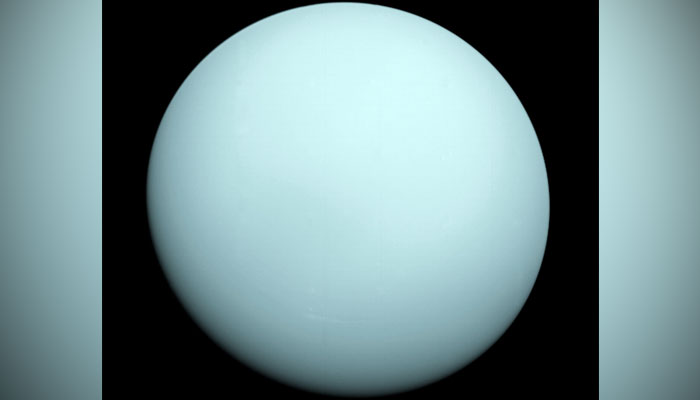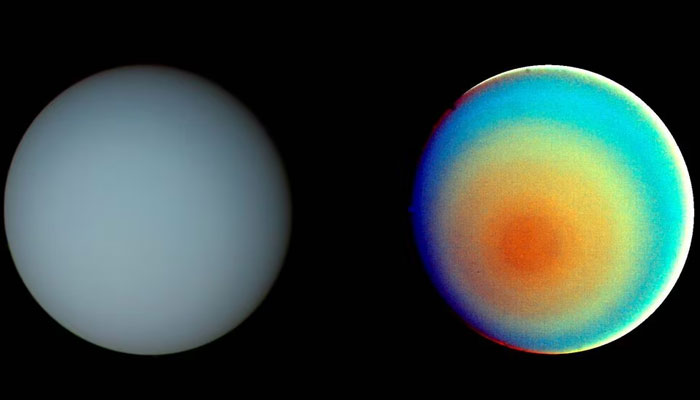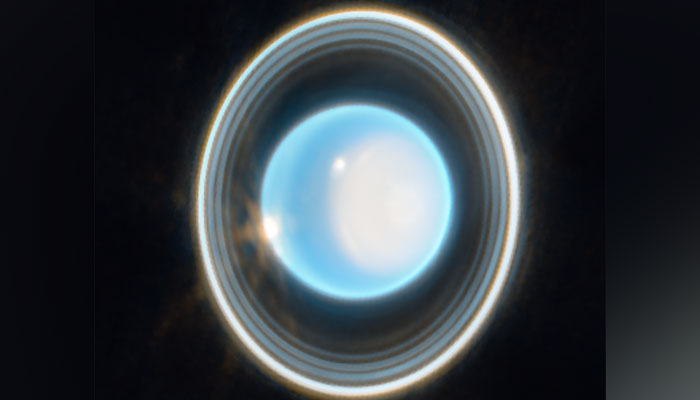Astronomers nearly solve Uranus atmosphere mystery
With help of telescopes, experts have been able to see more deeply into the atmosphere of the ice giant
May 26, 2023

New telescopic data harvested by US astronomers may hold the key to unlocking the mysteries surrounding the dynamism of the atmosphere of Uranus, the solar system’s seventh planet from the sun, which strangely spins on its side.
Uranus is regarded as a world of mystery which was seen only once as Nasa’s probe passed near the planet nearly four decades ago. The world with the third largest diameter in our solar system is still guarding its mysteries.
With the help of new observations from a telescope located in New Mexico, it detected a polar cyclone whose centre measures a quarter of Earth's diameter, swirling near its north pole.
Scientists published their findings in the journal Geophysical Research Letters.
This way the experts have been able to see more deeply into the atmosphere of the icy giant — similar to its neighbouring planet Neptune — than ever before.
"While the general makeup of its atmosphere and interior is similar to Neptune — as far as we know — Uranus has some pretty unique features," said planetary scientist Alex Akins of NASA's Jet Propulsion Laboratory in California, lead author of the study.

"It spins on its side. And even then, its magnetic field is still misaligned with its rotational axis. The atmospheric circulation and internal heat release appear weaker than Neptune, but there is still a range of dynamical features and storms that have been observed," Akins noted.
The planet, which appears blue-green in its colour due to methane gas contained in its atmosphere, is the third-largest planet in our solar system. Its atmosphere is made up of mostly hydrogen and helium.
It has a diameter of about 31,500 miles (50,700 km). Uranus is so big in size that 63 Earths can easily fit it.
Uranus' orbital path around the sun is about 1.8 billion miles (2.9 billion km) distance, almost 20 times farther than Earth does. Its orbit lasts 84 years.
Its unusual tilt makes Uranus appear to orbit the sun like a rolling ball.
The researchers used the Very Large Array telescope to see below the clouds at the top of the atmosphere, finding circulating air at the north pole that was warmer and drier, evidence of a strong cyclone.

They were able to estimate the size of the storm's centre but not the entire cyclone's diameter, though it potentially could be wider than Earth.
The research confirmed that polar cyclones are present on every planet in our solar system with a substantial atmosphere — all the planets but Mercury and even Saturn's moon Titan.
Akins said: "Polar cyclones are regions of high winds moving in a direction determined by the planet's rotation — clockwise on Venus, Uranus and anti-clockwise for the rest — with differing air properties between the inside and out."
"The way they form is different from planet to planet," Akins added.
"On Earth, their strength is modulated by season due to the amount of sunlight. We aren't quite sure yet how they form on Uranus. It's different from other cyclones in the sense that it's generally longer-lived and most likely forms from a different balance of atmospheric processes, and therefore is a more characteristic [enduring] feature of the atmosphere. That is unlike hurricanes, which form, move and dissipate on relatively short time scales."
Most of the mass of Uranus is a dense fluid of icy materials — water, methane and ammonia.
Two faint rings surround Uranus with 27 small moons orbiting it. The atmosphere is the coldest in Uranus compared to the eight planets, including outermost Neptune.
"There are a lot of unknowns," Akins said.
"How did it get tilted on its side? Is its interior really 'icier' than the gas giants [Jupiter and Saturn]? Why do we see atmospheric banding features that aren't aligned with the measured wind speeds? Why is the pole so much drier than the equator? Are its satellites [moons] ocean worlds?"









